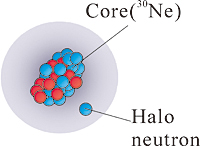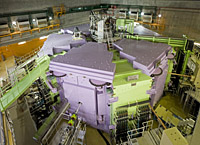Tokyo Tech scientists have proven the existence of quantum ‘halo’ states in heavy nuclei of neon for the first time
When atomic nuclei contain many more neutrons than protons, they become unstable structures that are on the verge of breaking apart. These so-called ‘exotic nuclei’ can exhibit some unusual quantum states, one of the most interesting of which is known as a neutron halo.
Now, Takashi Nakamura and colleagues at Tokyo Tech's Department of Physics in collaboration with an international team have produced the heaviest neutron halo yet, in a neutron-rich isotope of neon1(Fig.1).
The structure of tightly-packed protons and neutrons at the centre of an atom has been explained theoretically by a ‘nuclear shell model’, which is partly analogous to the shell model for electrons that orbit the nucleus. Furthermore, exotic nuclei can enter a different, weakly bound state in which one or two outer neutrons are decoupled from the other protons and neutrons, which remain in a tightly bound core.
This weakly bound state is aptly named a neutron halo, and gives rise to the possibility that the decoupled neutrons could extend into regions that are forbidden by classical mechanics to form the ’halo’(Fig.1). The radius of the halo sometimes becomes twice or three times larger than the tightly-packed core. However, this unique quantum state has only been confirmed in a few experimental systems, using neutron-rich isotopes of light elements from helium through to carbon. It is important to establish whether halos can exist in heavier nuclei such as neon.
The researchers chose the isotope 31Ne, which contains 10 protons and 21 neutrons, as a candidate for producing a halo state. The energy required to separate one neutron from the 31Ne core is quite low. This type of ‘single-neutron’ halo state has only been seen for three cases before, in lighter isotopes of beryllium and carbon, and it has not been clear whether such halos can exist abundantly in heavier systems.
What's more, 31Ne lies in a fascinating region of the nuclear chart known as the ‘island of inversion’, where the normal nuclear shell order appears to break down.
Unfortunately, it is not easy to make heavy extremely neutron rich nuclei! In order to produce a useful beam of heavy neon, Nakamura and colleagues, with their co-workers from across Japan, France and Austria, made use of the extremely powerful Radioactive Ion Beam Factory (RIBF, Fig.2) in Wako, Japan, which is operated by the RIKEN Nishina Center and the Centre for Nuclear Study at University of Tokyo.
At the RIBF, heavy nuclei are produced by bombarding a thick beryllium target with a beam of heavy calcium ions (48Ca). This collision produces a large variety of fragments, including 31Ne, which are separated based on their charge and mass in the ‘BigRIPS’ fragment separator. By this method the researchers were able to isolate a beam of about five 31Ne particles per second. This number is far smaller than the usual stable heavy ion beams of more than 10 billion particles per seconds, but even so it represents about a thousand times more 31Ne than were available previously.
The 31Ne beam was then directed onto a lead target, which caused each nucleus to lose a neutron. By counting and measuring the 31Ne nuclei incident on the targets, and 30Ne nuclei emerging from the targets, the researchers obtained information on the structure of 31Ne.
The results showed that the one-neutron removal process was dominated by Coulomb breakup – the removal of a decoupled outer neutron by the Coulomb force rather than by the short-range nuclear force - which is a signature that the nucleus was in a halo state(Fig.1). The researchers found further evidence of the halo state by comparing the results to models of various neutron configurations; this suggested that the outer neutron occupies an orbital halo state with low angular momentum.
In their paper, published in Physical Review Letters, the researchers say “the present result could hint that, owing to changes in shell structure, halos are more abundant than expected in ‘heavy’ neutron-rich nuclei.” They hope that by conducting more experiments, observing the breakup of 31Ne and other nuclei under various conditions, they could reveal further structural details of these fascinating exotic quantum systems.
Reference

Image of halo structure of 31Ne revealed in our experiments. The 31Ne was found to be composed of a tightly packed deformed 30Ne core surrounded by an extended halo neutron.

Superconducting Ring Cyclotron (SRC) at RIBF at RIKEN. Completed in 2006, this is the world's largest cyclotron. The SRC can accelerate heavy ions up to about 70% of the speed of light. In our experiments, an intense 48Ca beam at 345 MeV/nucleon was used to produce exotic nuclei 31Ne.
. Any information published on this site will be valid in relation to Science Tokyo.




